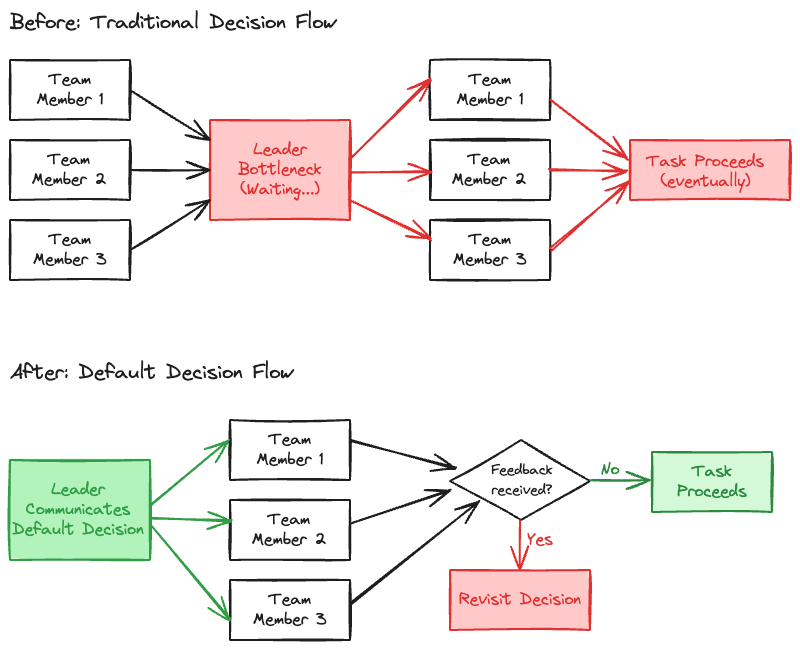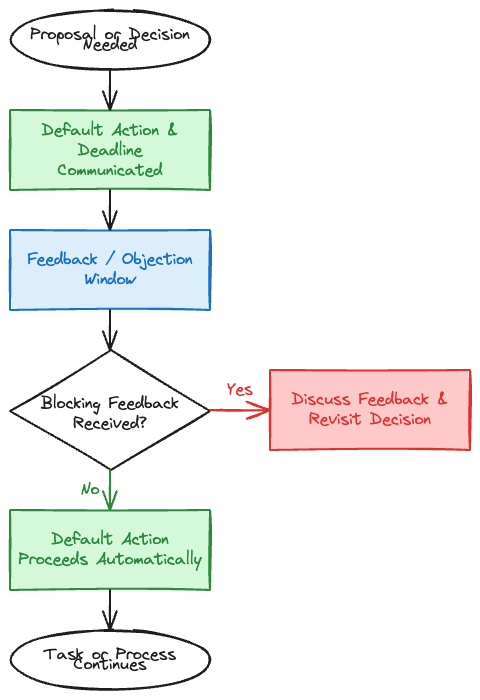As engineering leaders, our primary goal is to enable our teams to build great things efficiently. Yet, so many of us find ourselves tangled in a web of pending approvals and waiting games, the flow of work constantly interrupted. This isn’t just inefficient; it pulls our focus away from the strategic work that truly adds value. What if you could regain control of your time and empower your team to move forward autonomously, without sacrificing clarity or alignment?
Your value as a leader is ultimately measured by your team’s output: Is it the right thing? Is it done on time? Is it done well? Connecting your team with stakeholders and ensuring clear communication is a crucial part of the role. However, if getting stuck in the middle as the required point for every decision handoff leads to waiting and delays, you can unintentionally become the bottleneck holding back progress.
One helpful strategy I often use is what I call “default decisions.” This approach allows your team to move forward without waiting for approvals, making your life as a leader easier and less stressful while still keeping everyone informed about what to do and when. By using default decisions, you can create a more relaxed environment where everyone knows what to expect and can keep making progress. Let’s explore how this approach can benefit you and your team!

What Are Default Decisions?
A “default decision” is setting a clear expectation that if no feedback is received by a certain time a specific action will be taken. The decision is made by default, with no additional action needed. For instance, you might say to a team member, “If you don’t hear from me by the end of the day, assume your request is approved.” Or, when presenting a plan to an executive, you might say, “This is what we’re planning on doing. If you want us to do something different, let me know; otherwise, the team will begin on Monday.”
This approach eliminates ambiguity and creates a straightforward path forward. By establishing a default action, you empower your team to proceed without waiting for explicit approval or further discussion, which can often lead to delays.

Why Use Default Decisions?
1. Remove Bottlenecks
In any organization, especially in software engineering, we’ve all seen how bottlenecks can arise when decisions are delayed or people are waiting for approvals. Default decisions help mitigate this issue by providing a clear course of action. When team members know that they can proceed unless told otherwise, it fosters a sense of autonomy and accelerates progress.
2. Empower Your Team
When you implement default decisions, you’re not just streamlining processes; you’re also empowering your team. By giving them the authority to move forward with their work, you instill confidence and encourage initiative. This empowerment can lead to increased job satisfaction and a more engaged workforce, as team members feel their contributions are valued and impactful.
3. Keep Communication Clear
Default decisions also enhance communication. By clearly stating what will happen unless there is a response, you keep everyone informed about the plans and expectations. This transparency is essential in maintaining trust and alignment within your team. It ensures that everyone is on the same page and knows what to expect, which is especially important in busy environments where time is of the essence.
4. Adapt to Busy Schedules
As leaders, we understand that both we and our teams often juggle multiple priorities – it’s just the nature of the work! Default decisions cater to this reality. They allow decisions to be made quickly without requiring extensive back-and-forth communication. This is particularly beneficial in a fast-paced environment where time is a precious commodity.
Implementing Default Decisions
So, how can you start incorporating default decisions into your leadership style? Here are a few tips:
-
Be Clear and Specific: When you communicate a default decision, make sure it’s clear what the default action is and the timeline for feedback. For example, “We will move forward with the new feature implementation. If I don’t hear any objections by Friday, we’ll start development next week.”
-
Encourage Feedback: While the goal is to streamline decision-making, it’s also important to create an environment where team members feel comfortable voicing their concerns or disagreements. Make it clear that their input is valued and that the default decision is a way to facilitate progress, not to silence dissent. Emphasize that the purpose of the default is to prevent waiting, not to bypass discussion. Actively solicit opinions, perhaps by asking questions like, “Does anyone see any issues with this plan that I’m missing?” or “Is there a reason why this plan wouldn’t work?” Ensure people know that raising a concern before the deadline is expected and welcomed.
-
Reflect and Adjust: After implementing default decisions, take time to reflect on their effectiveness. Are they helping to drive action? Are team members comfortable with this approach? Adjust your strategy based on feedback and outcomes to ensure it continues to serve your team well.
Conclusion
Default decisions can make everyone’s life easier. By removing bottlenecks, enhancing communication, empowering your team, and adapting to busy schedules, you can create an environment where action is prioritized, and progress is made seamlessly. You bring value to your team and stakeholders, but you also stay out of the way.
As leaders, it’s our responsibility to pave the way for our teams, and default decisions are a simple yet effective tool in our leadership toolkit. So next time you find yourself faced with a decision, consider whether a default decision could help you and your team move forward with confidence and clarity. Start small, experiment with the approach on a routine decision, and observe the positive impact on speed and autonomy. Happy leading!
Photo by Vladislav Babienko on Unsplash